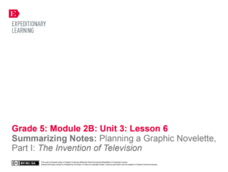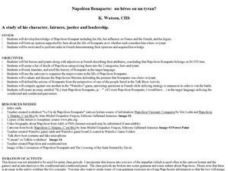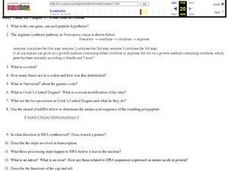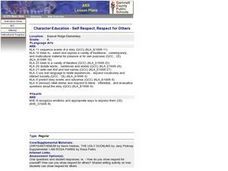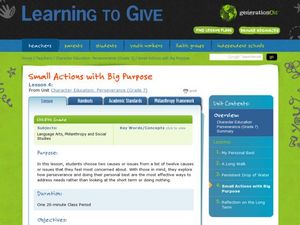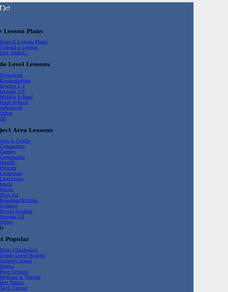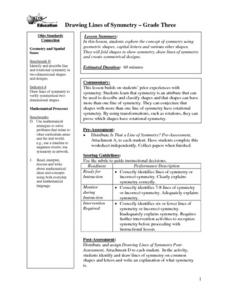EngageNY
Summarizing Notes: Planning a Graphic Novelette Part 1: The Invention of Television
What's the story? Learners create the first of four storyboards about the invention of the television, incorporating narrative techniques and descriptive details. Next, they offer and receive feedback by participating in a peer critique...
Curated OER
Johannes Gutenberg and the Printing Press
Students use library or online resources to create time lines on the life of Johannes Gutenberg and tell the impact his invention, the printing press, had on the development of newspapers.
Curated OER
Civil War Prison Camps
Fourth graders work with a partner to create a puppet show that demonstrates the condition of the prisoners in Andersonville, Georgia during the Civil War.
Curated OER
Music from Across America
Students complete a unit of lessons on a variety of types of American music. They record their impressions of music samples on a worksheet, identify types of instruments, and choose a musical selection for their family to respond to.
Curated OER
Napoléon Bonaparte: un héros ou un tyran?
Was Napoléon Bonaparte a hero or a tyrant? Discuss examples of each, and list their common attributes. Then, to form a solid argument and take a stance, intermediate and advanced Francophones conduct Internet research. After a few days...
Curated OER
From Gene to Protein Study Guide
In this biology worksheet, students review and answer different questions based upon the molecules of DNA and RNA. They look at the specific protein order of the DNA strand and its synthesis.
Perkins School for the Blind
Student Store
Vocational training activities are extremely important for learners with intellectual or physical disabilities. Here is a great idea that will help your class become skilled at money handling, basic economic concepts, interpersonal...
IPDAE
Themes in Short Stories
"What is the theme of this story?" The very question can spark fear in the minds of readers and incinerate confidence. Here you will discover an exercise that shows how writers use the tools of setting, plot, conflict, and...
Museum of Tolerance
Where Do Our Families Come From?
After a grand conversation about immigration to the United States, scholars interview a family member to learn about their journey to America. They then take their new-found knowledge and apply their findings to tracking their family...
NOAA
El Niño
El Nino, La Nina ... and the Santa Maria? The 11th installment of a 23-part NOAA Enrichment in Marine sciences and Oceanography (NEMO) program explains the mechanism of El Nino/Southern Oscillation. Pupils use previous data to determine...
Curated OER
Friendship and Death
Fourth graders share their thoughts and feelings about friendship and death and connect them with those of the characters in the book, The Bridge to Teribithia. They complete a friendship picture book and write a letter as one of the...
Curated OER
Going West
Young scholars examine the lives of early pioneers who traveled west for better opportunities. They listen to story "Josafina and the Story Quilt", and discuss hardships encountered by traveling families. Students then complete research...
Curated OER
Holidays in Kansas
Students identify holidays celebrated by different cultures in Kansas and create a timeline of when they started to be celebrated. In this Kansas holidays lesson plan, students create a timeline wall in their class for each holiday.
Curated OER
Character Education - Self Respect, Respect for Others
Students respond the story of Chrysanthemum by Kevin Henkes and discuss the ways in which she showed respect for herself and for others.
Curated OER
Character Education-Perseverance
Students learn what it means to stick to a task through the re-telling of the story, "The Little Engine That Could." Personal application is made to their own experiences with the completion of, "I think I can..." endings.
Curated OER
Take the Last Train to Clarksville: Arkansas's Historic Depots and Railroad History
Students study the history of railroads and depots in Arkansas using websites and memoirs. They complete activities that explain how and why the railroads were built, and the different ways people used them.
Curated OER
The Lewis and Clark Expedition
Students examine the Lewis and Clark expedition. They develop skills for historical analysis. They locate a variety of geographic features encountered by the expedition, and create a timeline that documents Lewis and Clark on their journey.
Curated OER
Extremely Personal Narrative
Seventh graders practice the skill of writing a personal narrative. They bring in an object that is related to themselves. Then students discuss the importance of the items and then write a personal narrative about the objects. As an...
Curated OER
Fable Writing
Students listen to and discuss various fables, and identify the moral and central themes. They write their own personal fables and create illustrations to go with them.
Curated OER
Why Walk?
Following the story Yummers, pupils will use the food pyramid to evaluate what Emily Pig ate during her walk and find out why her walk made her sick. They will then participate in a walking game.
Curated OER
Down the Knoll Without the Water
Students use a thesaurus to find synonyms for selected words in fairy tales.
Curated OER
Create Your Island Paradise
Sixth graders create a descriptive essay and map describing their island paradise. They try to evoke the reader's senses: seeing, hearing, touching, smelling, and tasting. They revise their paragraphs using their partner's feedback.
Curated OER
Drawing Lines of Symmetry
Third graders explore the concept of symmetry using geometric shapes, capital letters and various other shapes. They fold shapes to show symmetry, draw lines of symmetry and create symmetrical designs.
Curated OER
Boarding School vs. Day School Experiences
Pupils compare and contrast the lives of Hopi children that attend boarding school and those that attend day school. In this schools lesson plan, students understand changes over time as they look at these schools chronologically.


